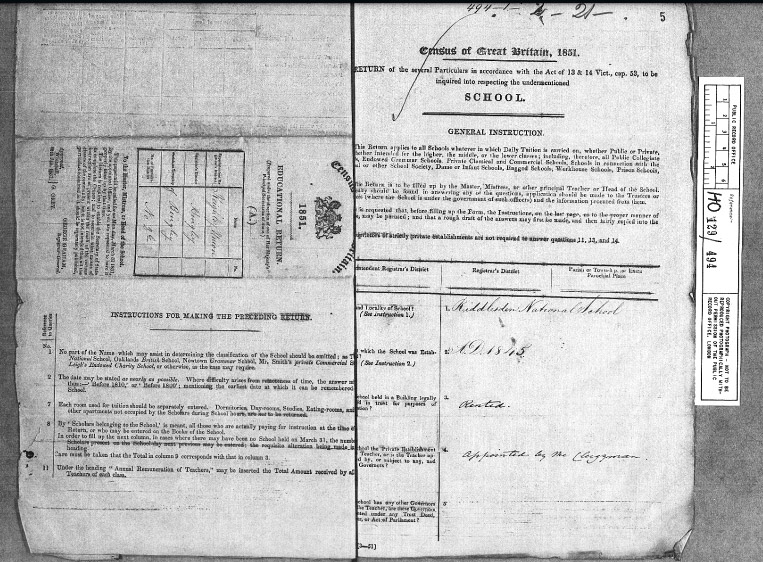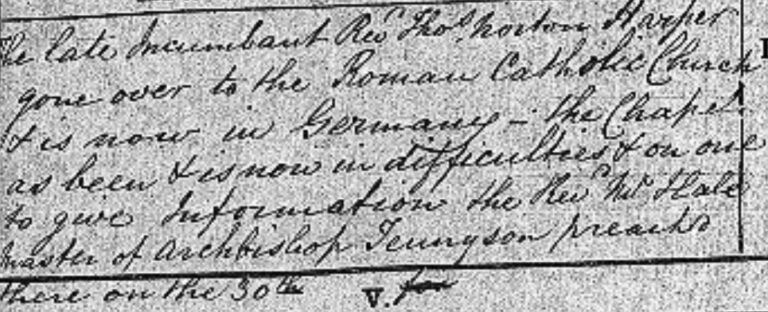As part of National Volunteers’ week, I’d like to celebrate with you the completion of a volunteer transcription project, currently being uploaded to Discovery.
We enlisted the help of volunteers from all over the world and, in a new departure for The National Archives, we used a third-party platform called From The Page. This meant that we could upload images to their site, and create online forms for the volunteers to input information. There was also a facility for volunteers to comment on issues arising that were not covered by the original instructions – and there were plenty of those!
The Ecclesiastical Census of 1851 was taken at the same time as the regular population census, but the records are used much less, although they have been available for several years as digital microfilm, free downloads from The National Archives. Until now, they were catalogued only by registration district, but with no additional details. This means that the value of the records was easily overlooked, but thanks to volunteers’ efforts, the extra information now being added to Discovery will open them up for new areas of research.
The purpose of the census was to establish the provision for religious worship in England and Wales, and the strength of the various religious denominations; in particular, information was sought on developments since 1800, a period of massive social and economic change. The Church of England thought that the results would be biased towards nonconformist denominations, who considered, in turn, that they would be biased towards the Church of England. The enumerators who distributed the schedules for the population census also delivered special schedules to each place of worship in their district, but not all were returned, and there were no penalties for non-completion.
In practice, many enumerators or registrars had to complete the schedules, as best they could, when they could not collect them from the church or chapel concerned. Some clergy even wrote on the schedule that they refused to comply, and there are duplicate entries for some places, where two different officials completed and returned the schedules. Some smaller congregations are likely to have been missed, because the enumerator was not aware of them – for example, if they met in a schoolroom, or a room in a dwelling-house.

So the returns are known to be unreliable, and those for five registration districts – Bridgwater, Bristol, Stockport, Halifax and Festiniog – are missing altogether. But the information recorded is still very useful, and tells us a lot about religious worship in the mid-19th century.
There was one type of schedule (portrait format) for Church of England churches and chapels, and a landscape version for all other denominations, including Jewish synagogues, with a special one for the Society of Friends (Quakers). Despite their apparent differences, they recorded the same basic information.
We asked the volunteers to transcribe the name and location of the place of worship, its date of foundation, denomination, the number of attendees on 31 March 1851, and the name and status of the person who completed the schedule. This is not a full transcription, and it is always worth looking at the actual schedule images for more information, such as the notes, and some entirely unsolicited comments in the margins and elsewhere.

We provided a drop-down menu of denominations to help the volunteers, covering most of those they were likely to encounter, but we had to expand this from time to time – it’s amazing just how many different varieties of Methodist and Baptists there were, let alone some others! Some of the comments were on the architectural details or history of the building, but many more said how bad the weather was that day, and how much bigger the congregation would have been otherwise.
When the completed returns were deposited with the Public Record Office, they arrived as bound volumes, for each Registration District, but no further cataloguing was done until now. This volunteer project may be the first time that every page in the whole record series has been examined since the results were collated in the 1850s, and some problems and inconsistencies have come to light as a result. We asked the volunteers to record the folio number for each schedule, and this was harder than you might think. The foliation is inconsistent, to say the least, and at least one parish was bound with a volume in another county, very likely because if had a similar name to a parish there.
In 1983 the records were filmed, making them more widely available than they were as originals. But, as with any kind of copying, there is always a down side. When records are filmed, there is the chance of two pages being turned over at once, which has happened on a few occasions here, and some pages were filmed without removing pieces of paper that partly obscured them. So one of the great benefits of this volunteer project was to bring these minor issues to light, and while we cannot change the original records, we can at least add a note to the catalogue entry.

But the great benefit of the project is that the records can now be searched by place, and by denomination. The only personal names are those of the clergy, stewards, secretaries and others who completed the schedules, but these can be surprisingly useful. Many nonconformist congregations did not have full-time clergy, so that an ancestor’s appearance here may be the first indication that he (or she) was associated with a particular denomination. The names of some nonconformist clergy appear in more than one district, or even county, shedding light on the way some denominations were organised. Another incidental benefit is that the locations of the few surviving fragments of the Education Census, taken at the same time, are being identified.
The volunteers completed the transcription ahead of schedule, and many of the results have been checked and uploaded to Discovery. When the process is complete, it will make the whole record series much more accessible than ever before, to the benefit of researchers worldwide.
An informative article about an interesting record !
Oxfordshire Record Society have published in book form Dr Kate Tiller’s transcription for historic Oxfordshire. Although published and issued to subscribers in 1987, it is not out of print :-
“Church and chapel in Oxfordshire, 1851 : the return of the census of religious worship”
Surrey has also appeared in an edited edition by the Surrey Record Society and is also still in print
According to ‘Table A’ of the Report on Religious Worship, published in 1853, there were 2,871 Primitive Methodist places of worship in England and Wales in 1851. Having downloaded the appropriate returns from TNA website, I set myself the task of transcribing those in England. The the transcripts so far completed appear on the website ‘My Primitive Methodists’ http://www.myprimitivemethodists.org. After much trial and error I use an Excel spreadsheet as a blank form and try to add the data in the layout used on the original. I am also compiling and analysing the data and hope to produce a series of ‘County Reports’, including location maps.
The figures are unreliable because they asked for three attendances, Morning, Afternoon and Evening but did not specify that the people had to be different. A keen attender at all three services would have been counted three times! To compensate for this omission the attendance figure given is morning +afternoon/2 + evening/3, which means the original data is useless. Far more interesting are the number of Denominations or Sects, as they are referred too. Poor old Horace Mann made much of the one piece of data he thought reliable- Number of sittings (Seats) and concluded there was a shortage if everyone wanted to attend church. He forgets that like school dinners you can have more than one Sitting. He also missed the Independent Methodists giving them 21 churches whereas they actually had 63. He did not realise that they were a separate Denomination not just Methodists who were self governing. He does not mention them in his history of Religion in Britain.